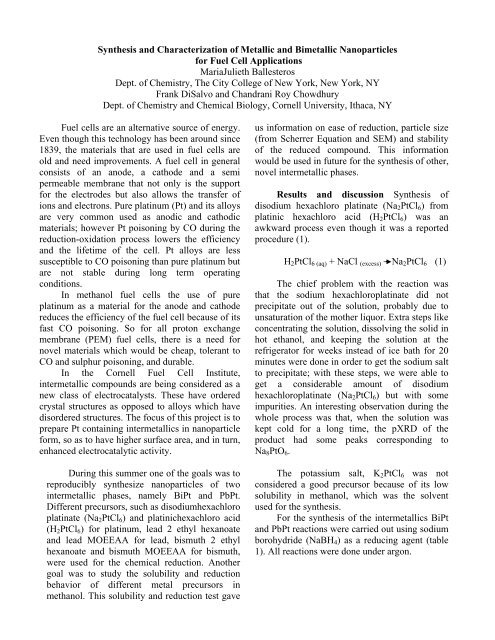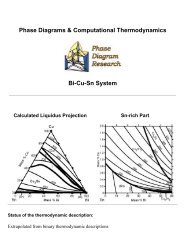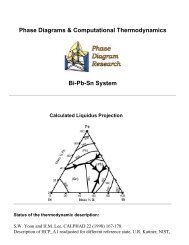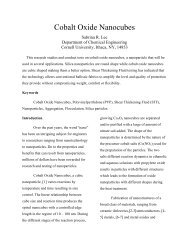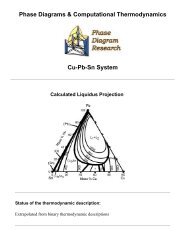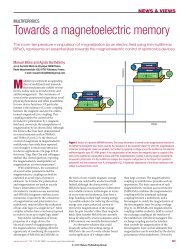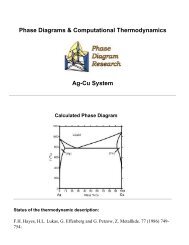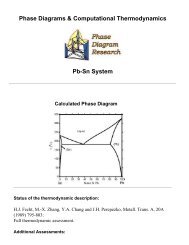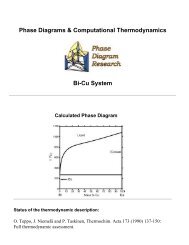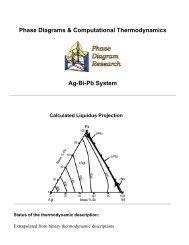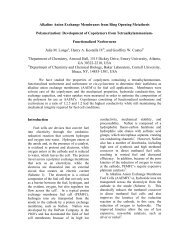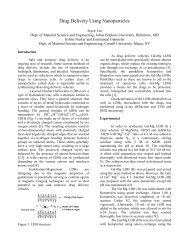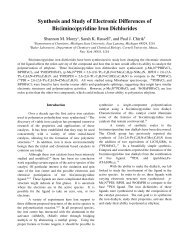Synthesis and Characterization of Metallic and Bimetallic ... - MatDL
Synthesis and Characterization of Metallic and Bimetallic ... - MatDL
Synthesis and Characterization of Metallic and Bimetallic ... - MatDL
You also want an ePaper? Increase the reach of your titles
YUMPU automatically turns print PDFs into web optimized ePapers that Google loves.
<strong>Synthesis</strong> <strong>and</strong> <strong>Characterization</strong> <strong>of</strong> <strong>Metallic</strong> <strong>and</strong> <strong>Bimetallic</strong> Nanoparticlesfor Fuel Cell ApplicationsMariaJulieth BallesterosDept. <strong>of</strong> Chemistry, The City College <strong>of</strong> New York, New York, NYFrank DiSalvo <strong>and</strong> Ch<strong>and</strong>rani Roy ChowdhuryDept. <strong>of</strong> Chemistry <strong>and</strong> Chemical Biology, Cornell University, Ithaca, NYFuel cells are an alternative source <strong>of</strong> energy.Even though this technology has been around since1839, the materials that are used in fuel cells areold <strong>and</strong> need improvements. A fuel cell in generalconsists <strong>of</strong> an anode, a cathode <strong>and</strong> a semipermeable membrane that not only is the supportfor the electrodes but also allows the transfer <strong>of</strong>ions <strong>and</strong> electrons. Pure platinum (Pt) <strong>and</strong> its alloysare very common used as anodic <strong>and</strong> cathodicmaterials; however Pt poisoning by CO during thereduction-oxidation process lowers the efficiency<strong>and</strong> the lifetime <strong>of</strong> the cell. Pt alloys are lesssusceptible to CO poisoning than pure platinum butare not stable during long term operatingconditions.In methanol fuel cells the use <strong>of</strong> pureplatinum as a material for the anode <strong>and</strong> cathodereduces the efficiency <strong>of</strong> the fuel cell because <strong>of</strong> itsfast CO poisoning. So for all proton exchangemembrane (PEM) fuel cells, there is a need fornovel materials which would be cheap, tolerant toCO <strong>and</strong> sulphur poisoning, <strong>and</strong> durable.In the Cornell Fuel Cell Institute,intermetallic compounds are being considered as anew class <strong>of</strong> electrocatalysts. These have orderedcrystal structures as opposed to alloys which havedisordered structures. The focus <strong>of</strong> this project is toprepare Pt containing intermetallics in nanoparticleform, so as to have higher surface area, <strong>and</strong> in turn,enhanced electrocatalytic activity.During this summer one <strong>of</strong> the goals was toreproducibly synthesize nanoparticles <strong>of</strong> twointermetallic phases, namely BiPt <strong>and</strong> PbPt.Different precursors, such as disodiumhexachloroplatinate (Na 2 PtCl 6 ) <strong>and</strong> platinichexachloro acid(H 2 PtCl 6 ) for platinum, lead 2 ethyl hexanoate<strong>and</strong> lead MOEEAA for lead, bismuth 2 ethylhexanoate <strong>and</strong> bismuth MOEEAA for bismuth,were used for the chemical reduction. Anothergoal was to study the solubility <strong>and</strong> reductionbehavior <strong>of</strong> different metal precursors inmethanol. This solubility <strong>and</strong> reduction test gaveus information on ease <strong>of</strong> reduction, particle size(from Scherrer Equation <strong>and</strong> SEM) <strong>and</strong> stability<strong>of</strong> the reduced compound. This informationwould be used in future for the synthesis <strong>of</strong> other,novel intermetallic phases.Results <strong>and</strong> discussion <strong>Synthesis</strong> <strong>of</strong>disodium hexachloro platinate (Na 2 PtCl 6 ) fromplatinic hexachloro acid (H 2 PtCl 6 ) was anawkward process even though it was a reportedprocedure (1).H 2 PtCl 6 (aq) + NaCl (excess) Na 2 PtCl 6 (1)The chief problem with the reaction wasthat the sodium hexachloroplatinate did notprecipitate out <strong>of</strong> the solution, probably due tounsaturation <strong>of</strong> the mother liquor. Extra steps likeconcentrating the solution, dissolving the solid inhot ethanol, <strong>and</strong> keeping the solution at therefrigerator for weeks instead <strong>of</strong> ice bath for 20minutes were done in order to get the sodium saltto precipitate; with these steps, we were able toget a considerable amount <strong>of</strong> disodiumhexachloroplatinate (Na 2 PtCl 6 ) but with someimpurities. An interesting observation during thewhole process was that, when the solution waskept cold for a long time, the pXRD <strong>of</strong> theproduct had some peaks corresponding toNa 8 PtO 6 .The potassium salt, K 2 PtCl 6 was notconsidered a good precursor because <strong>of</strong> its lowsolubility in methanol, which was the solventused for the synthesis.For the synthesis <strong>of</strong> the intermetallics BiPt<strong>and</strong> PbPt reactions were carried out using sodiumborohydride (NaBH 4 ) as a reducing agent (table1). All reactions were done under argon.
Platinum Bismuth orprecursor Lead precursorProductH 2 PtCl 6 Bi-MOEEAA BiPtH 2 PtCl 6Bi 2-ethylhexanoateBiPt, PtNa 2 PtCl 6Bi-2-ethyl Bi, Pt, Na,hexanoate Bismuth OxidesH 2 PtCl 6 Pb-MOEEAA PbPtNa 2 PtCl 6Pb-2-ethylhexanoatePbPt, PbTable 1 List <strong>of</strong> the attempts to prepare the intermetallicsBiPt <strong>and</strong> PbPt <strong>and</strong> its product. MOEEAA {2,[2,(2methoxy), ethoxy]ethoxy}Acetic AcidThe highlighted reactions are the ones thatproduced ordered intermetallic phase products;the other reactions showed some Bi <strong>and</strong> Pb oxideimpurities <strong>and</strong> elemental platinum. Themorphology <strong>of</strong> the pure intermetallic phasesobtained were studied by scanning electronmicroscopy (SEM) to get accurate information onparticle size <strong>and</strong> agglomeration effects. The SEMshowed agglomerates <strong>of</strong> nanoparticles asexpected due to the absence <strong>of</strong> the surfactants,which can separate nanoparticle clusters intosingle or smaller nanoparticles clusters.between the MOEEAA <strong>and</strong> ethyl hexanoateprecursors, a chloride test was done. LithiumChloride (LiCl) was added to the Bi <strong>and</strong> Pbprecursors <strong>and</strong> we looked for the formation <strong>of</strong> aprecipitate. This test gave us some pXRD database useful for underst<strong>and</strong>ing the possibleformation <strong>of</strong> PbCl 2 <strong>and</strong> BiCl 3 during thepreparation <strong>of</strong> the intermetallics. The chloridetest was also tried for sodium hexachloropalladate.Precursor Precipitate XRDBi MOEEAA yes BiOCl, BiOPbMOEEAAno noBi 2-ethylhexanoateyes BiO Cl, BiOPb 2-ethylNo (stickyyeshexanoateprecipitate)*Sodiumhexachloro no nopalladateTable 2 List <strong>of</strong> the trials for chloride precipitation testusing lithium chloride (in bold primary product).*XRD for Pb 2-ethyl hexanoate was not taken because welost a lot <strong>of</strong> the sample that got stuck to the mortar.And I tried just for fun, the following reactionNa 2 PdCl 6 4H 2 O + H 2 PtCl 6 + NaBH 4 PtPdThe pXRD <strong>of</strong> the reduction <strong>of</strong> platinum (Pt) <strong>and</strong>palladium (Pd) shows single peak for both metalsbecause they form an alloy with identical pXRD.100nm scale(a)200nm scaleFigure 2 SEM picture <strong>of</strong> the alloy PdPt. The spikes shapevisi ble in the picture shows the typical behavior <strong>of</strong> an alloyho wever surprisingly we found some areas with roundshapes.200 nm scale (b)Figure 1(a) (b) SEM pictures <strong>of</strong> the intermetallics clusters(a) BiPt nanoparticles cluster (b) PbPt nanoparticles clustershowing some plate like areas.In order to underst<strong>and</strong> the possible effect <strong>of</strong>halogen in the synthesis <strong>and</strong> the differencesAs mentioned before some precursors were testedfor solubility <strong>and</strong> reduction using sodiumBorohydrate (NaBH 4 ). This procedure wascarried out under argon <strong>and</strong> the solvent( methanol) was degassed for 2 hours. In order toachieve the solubility <strong>of</strong> the salt sonication, <strong>and</strong>
heating were done (if necessary). The followingtable shows the list <strong>of</strong> salts used for solubilitytest.PrecursorSodiumhexachloropalladateAmmonium-ptungstateCobalt( II)oxalatedehydrateGallium(III)Nitrate hydrateSilver acetateanhydrousSol.MeOHRed.Part. domainsize (nm)yes yes 10.21no no nono no noyesnotred.nono no noNickel sulfate* yes yes noNickelnotpartiallycarbonatered.noSilvercarbonateno no noSilver cyanate sl ight no noIndiumphosphatesl ight no noGermaniummonosulphateslight no noThalliumsulfidesl ight no noIndiumsulphate**yes yes noT able 3 List <strong>of</strong> salts used for solu bility test <strong>and</strong> particledomain size* Nickel particle domain size was not calculated becausethe sample was exposed to air making some <strong>of</strong> the nickel tooxidize back.**The solubility in methanol <strong>of</strong> indium sulfate requiredheating then at the moment we added the reduction agentthe sample was hot, <strong>and</strong> it seem to be an incompletereductionConclusionsWe were able to obtain the sodiumhexachloroplatinate precursor by modifying theprocedure from literature; in addition, we noticedthat the precipitate starts forming from themother liquid after 1 or 2 weeks in therefrigerator at about 4 o C. The next step for thisreaction is to try to get the precipitate using thest<strong>and</strong>ard procedure, the same NaCl salt but with asaturated solution <strong>of</strong> platinic hexachloro acid(H 2 PtCl 6 ).We were able to reproduce thenanoparticle synthesis <strong>of</strong> two intermetallicphases, namely BiPt <strong>and</strong> PbPt by the chemicalreduction <strong>of</strong> different precursors. However forsome reactions the impurities or the unreactedmetals need further study. From solubility <strong>and</strong>reduction test we got relevant information forpalladium, once it was the only compound thatreally showed solubility <strong>and</strong> stability after beingreduced. Further reactions may be consideredusing this compound as a precursor for newintermetallics.The SEM pictures for the twointermetallics compounds showed very differentmorphology <strong>of</strong> the sample due to a differentagglomeration pattern <strong>of</strong> the nanoparticles. PbPtnanoparticles clusters showed two types <strong>of</strong>agglomerates one like a flat shape <strong>and</strong> the othercloud-like shape; meanwhile for BiPt we did notobserve any major change in the nanoparticlesclusters. PdPt alloy show an interesting roundshape among the spikes shape ones typical <strong>of</strong> analloy.AcknowledgementsThanks to…. Frank DiSalvo, mentor, for lettingme be part <strong>of</strong> his group during this summer.To Ch<strong>and</strong>rani Roy Chowdhury for teaching meall she could related with the fuel cells project<strong>and</strong> for giving me the chance to try new reactions<strong>and</strong> work with fancy equipment. I hope you gotsomething relevant or at least the not to do list!Also thanks to DiSalvo’s group for being helpfulwhen I needed.Cornell Center for Materials Research, Thanks alot. I had learn a lot <strong>and</strong> I had so much fun atCornell.References1. Ch<strong>and</strong>rani Roy Choudhury <strong>and</strong> Francis JDiSalvo Chem mater.2005, XX,XXXX2. Raimondi, F.; G.G.Scherer; R. Kotz, <strong>and</strong> A.Wokaum Angew. Chem. int. Ed 2005, 44, 2190-22093. Casado-Rivera, E.; D. J. Volpe; L. Alden; C.Lind; C. Downie; T. Vazquez-Alvarez; A.C.D.Angelo; F. Di Salvo <strong>and</strong> H. Abruna J. Am.Chem.Soc. 2004, 126, 4043-40494. CornellFuel Cell Institute web page


